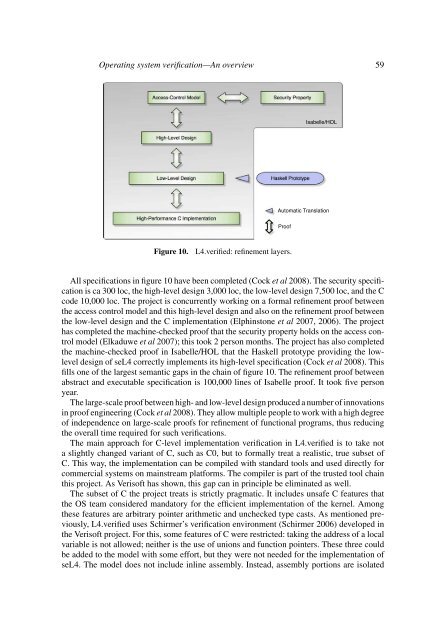Operating system verificationâAn overview
Operating system verificationâAn overview
Operating system verificationâAn overview
Create successful ePaper yourself
Turn your PDF publications into a flip-book with our unique Google optimized e-Paper software.
<strong>Operating</strong> <strong>system</strong> verification—An <strong>overview</strong> 59<br />
Access-Control Model<br />
Security Property<br />
Isabelle/HOL<br />
High-Level Design<br />
Low-Level Design<br />
Haskell Prototype<br />
High-Performance C Implementation<br />
Automatic Translation<br />
Proof<br />
Figure 10.<br />
L4.verified: refinement layers.<br />
All specifications in figure 10 have been completed (Cock et al 2008). The security specification<br />
is ca 300 loc, the high-level design 3,000 loc, the low-level design 7,500 loc, and the C<br />
code 10,000 loc. The project is concurrently working on a formal refinement proof between<br />
the access control model and this high-level design and also on the refinement proof between<br />
the low-level design and the C implementation (Elphinstone et al 2007, 2006). The project<br />
has completed the machine-checked proof that the security property holds on the access control<br />
model (Elkaduwe et al 2007); this took 2 person months. The project has also completed<br />
the machine-checked proof in Isabelle/HOL that the Haskell prototype providing the lowlevel<br />
design of seL4 correctly implements its high-level specification (Cock et al 2008). This<br />
fills one of the largest semantic gaps in the chain of figure 10. The refinement proof between<br />
abstract and executable specification is 100,000 lines of Isabelle proof. It took five person<br />
year.<br />
The large-scale proof between high- and low-level design produced a number of innovations<br />
in proof engineering (Cock et al 2008). They allow multiple people to work with a high degree<br />
of independence on large-scale proofs for refinement of functional programs, thus reducing<br />
the overall time required for such verifications.<br />
The main approach for C-level implementation verification in L4.verified is to take not<br />
a slightly changed variant of C, such as C0, but to formally treat a realistic, true subset of<br />
C. This way, the implementation can be compiled with standard tools and used directly for<br />
commercial <strong>system</strong>s on mainstream platforms. The compiler is part of the trusted tool chain<br />
this project. As Verisoft has shown, this gap can in principle be eliminated as well.<br />
The subset of C the project treats is strictly pragmatic. It includes unsafe C features that<br />
the OS team considered mandatory for the efficient implementation of the kernel. Among<br />
these features are arbitrary pointer arithmetic and unchecked type casts. As mentioned previously,<br />
L4.verified uses Schirmer’s verification environment (Schirmer 2006) developed in<br />
the Verisoft project. For this, some features of C were restricted: taking the address of a local<br />
variable is not allowed; neither is the use of unions and function pointers. These three could<br />
be added to the model with some effort, but they were not needed for the implementation of<br />
seL4. The model does not include inline assembly. Instead, assembly portions are isolated
















